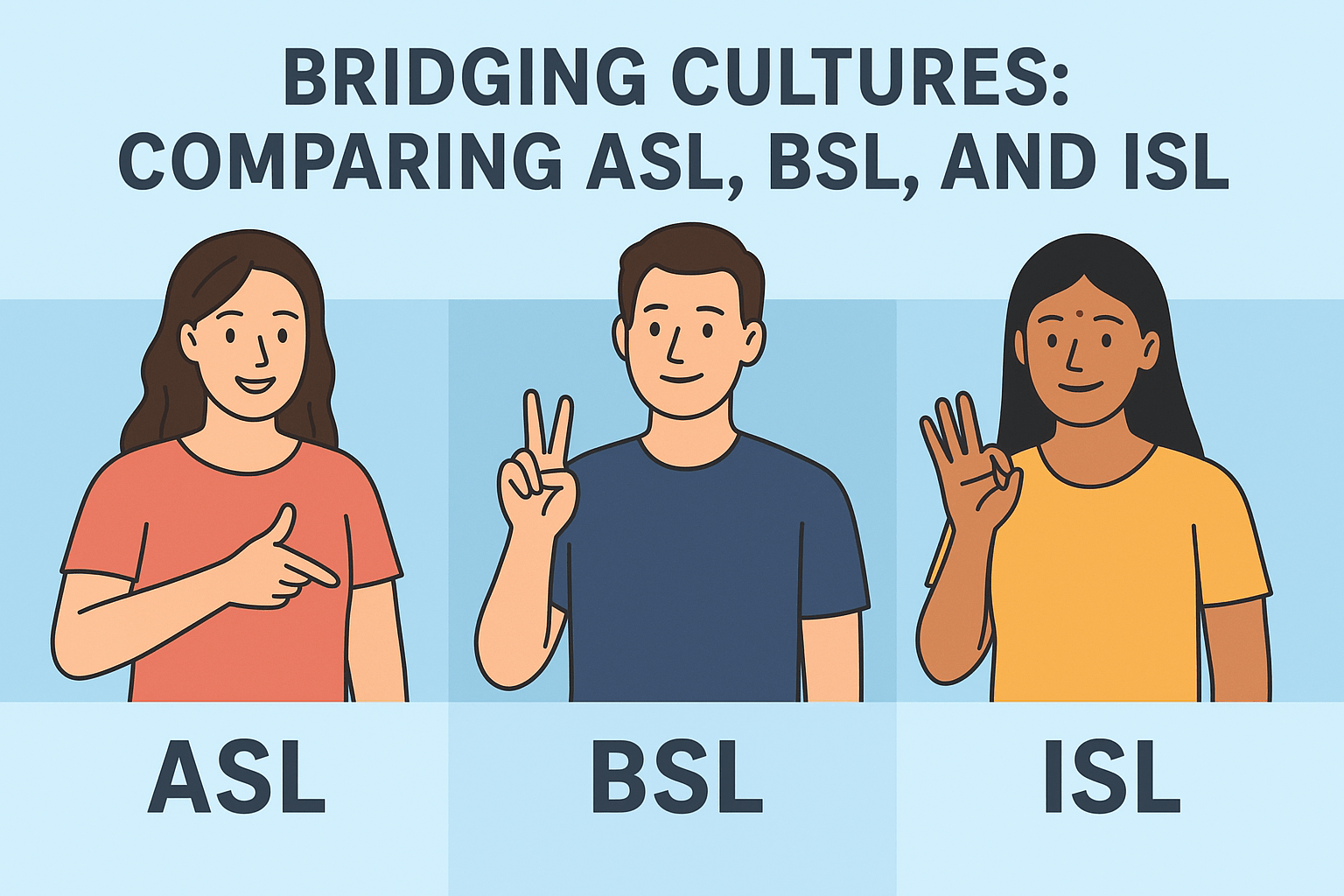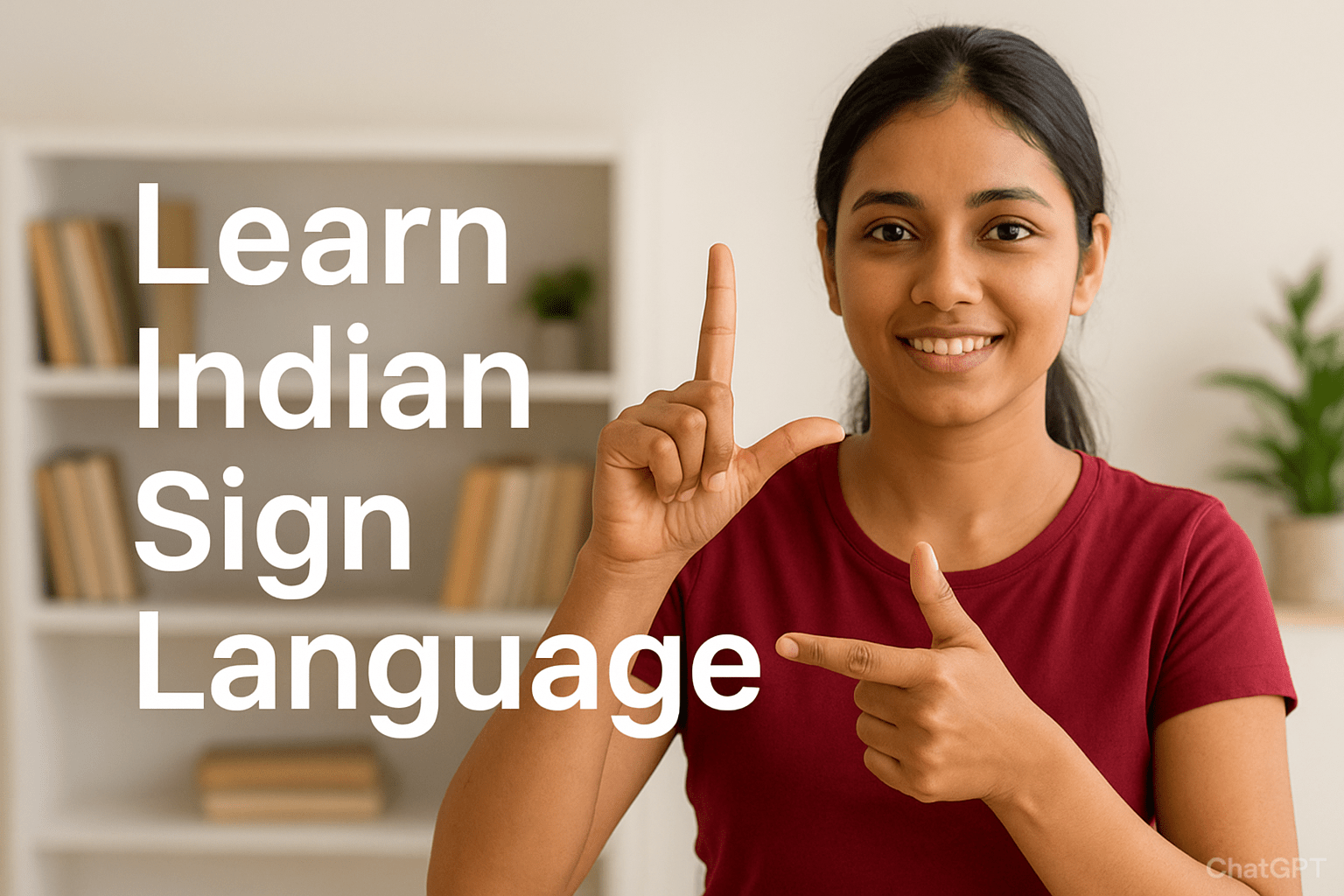One Language? Think Again!
If you’ve ever thought there was just one universal sign language, you’re not alone — many people do. I used to think the same until I met Deaf friends from different countries.
When one signed “thank you” and another looked puzzled, I realized: sign languages are as diverse as spoken ones.
In this post, we’ll take a friendly journey through ASL (American Sign Language), BSL (British Sign Language), and ISL (Indian Sign Language) — three beautiful languages that share a visual soul but express culture in their own unique ways.
By the end, you’ll not only know how they differ but also understand why that diversity is something to celebrate. 🌎
1. Meet the Three Languages
American Sign Language (ASL)
Used across the United States and parts of Canada, ASL is one of the most recognized sign languages in the world. Its roots trace back to the early 1800s when French educator Laurent Clerc helped shape it from French Sign Language (LSF).
What’s fascinating is how expressive ASL is — one sign can replace an entire English sentence, and meaning depends a lot on your face and tone. It’s quick, visual, and full of rhythm.
British Sign Language (BSL)
Across the ocean, BSL grew up entirely on its own. Though Americans and Britons both speak English, ASL and BSL are not mutually understandable — not even close!
One major difference? The alphabet. ASL fingerspelling is one-handed; BSL uses both hands.
BSL is known for its clarity and structure. It’s a bit more spatial, with signers using more space around them to describe who’s where and what’s happening.
Indian Sign Language (ISL)
Closer to home, ISL is the heart of communication for the Deaf community in India. It’s a rich blend of regional influences and local gestures, reflecting India’s linguistic diversity.
Over the past few years, thanks to institutions like the Indian Sign Language Research and Training Centre (ISLRTC), ISL is finally getting the national recognition it deserves.
You’ll find a detailed dive into ISL’s background in our earlier post:
👉 Indian Sign Language: History, Usage & Learning Tips.
2. How ASL, BSL, and ISL Differ
It’s easiest to see the differences when you look at basic signs:
| Concept | ASL | BSL | ISL |
|---|---|---|---|
| Thank you | Hand moves forward from chin | Hand moves out from lips | Hand moves slightly downward from chin |
| Mother | Open hand on chin | Thumb on chin | Flat hand, fingers open at chin |
| Yes | Fist nods up and down | One-hand gesture | Small nod or chin dip |
Even grammar changes:
- ASL: “Me go store tomorrow.” (topic–comment style)
- BSL: “Tomorrow, me go store.” (spatial order)
- ISL: Often mirrors Hindi structure — subject + object + verb.
Once you start noticing these differences, you realize how each sign language has evolved alongside its culture and spoken languages.
3. Why Culture Matters in Signing
Language is never just words — or in this case, signs. It’s a reflection of how people live, think, and feel.
In ASL, storytelling and expressive art are deeply valued. Deaf poetry and performance are vibrant and emotional.
BSL speakers, on the other hand, often have strong regional “accents” in their signing. A person from London may sign differently from someone in Scotland!
And ISL, with its influence from many Indian languages, feels colorful and rhythmic — a language that mirrors India’s diversity.
You can learn more about how facial expressions play a big role in this cultural depth in our post on
👉 Facial Expressions & Grammar in Sign Language.
4. The Shared Visual Heart
Despite the differences, there’s something magical that unites all sign languages — their visual logic.
Emotions like happy, sad, and angry are almost universally recognizable, and so are many natural gestures.
That’s why even signers from different countries can sometimes understand each other through shared expressions, laughter, and body language. There’s something beautiful about that silent connection.
5. Thinking of Learning More Than One? Here’s How.
If you already know a bit of one sign language, learning another can actually be fun — and incredibly rewarding!
Here’s how you can start:
- Compare videos: Watch creators from different countries on YouTube to spot visual differences.
- Keep a sign journal: Note how each sign feels — its motion, emotion, and intent.
- Use the Sign Academy Dictionary: Our Sign Dictionary lets you search for ASL, ISL, and other regional signs with example videos.
- Don’t mix systems: Think of each sign language as its own language, not just a variation.
The more you explore, the more you’ll begin to “think visually,” not verbally.
6. The Future: Connected, Yet Unique
With the world becoming more connected, Deaf communities are meeting and signing with each other more than ever. A kind of “International Sign” has emerged — a simplified blend of global sign languages used at international events.
But that doesn’t mean ASL, BSL, and ISL are merging. Each continues to thrive as a cultural identity, passed down through families, schools, and Deaf communities.
That’s the beauty of it — a global family connected by hands, yet defined by culture. 💛
Conclusion: Celebrate the Difference
When you see someone signing, you’re not just seeing hand movements — you’re witnessing a living language, carrying generations of stories, struggles, and love.
Whether you connect more with ASL’s expressiveness, BSL’s structure, or ISL’s cultural rhythm, learning even a little can open your world.
So next time someone asks, “Isn’t sign language the same everywhere?”, smile and say — “Not at all, and that’s what makes it wonderful.” ✨


